by MK PALOMAR
At the opening of the artist and illustrator Mary Kuper’s exhibition Language Shift, at the Southbank Centre, London, Chris McCabe, the director of the National Poetry Library, spoke about endangered languages and the Endangered Poetry Project. Language shift, McCabe explained, is a term given by academics to a spoken language that moves from an indigenous language to a common language – most often English. “There are,” McCabe added, “within this world of language, what the writer Paul Auster terms ‘unsung shadow heroes of literature’”, those who translate from one language into another, and there are also those writers and poets who choose to write in their own endangered language. These writers are, McCabe says, “courageous activists [and often] the last to go down”. They are the last people to stand for, and speak in, their indigenous tongue before it slips away, gone for ever and replaced by a common word.
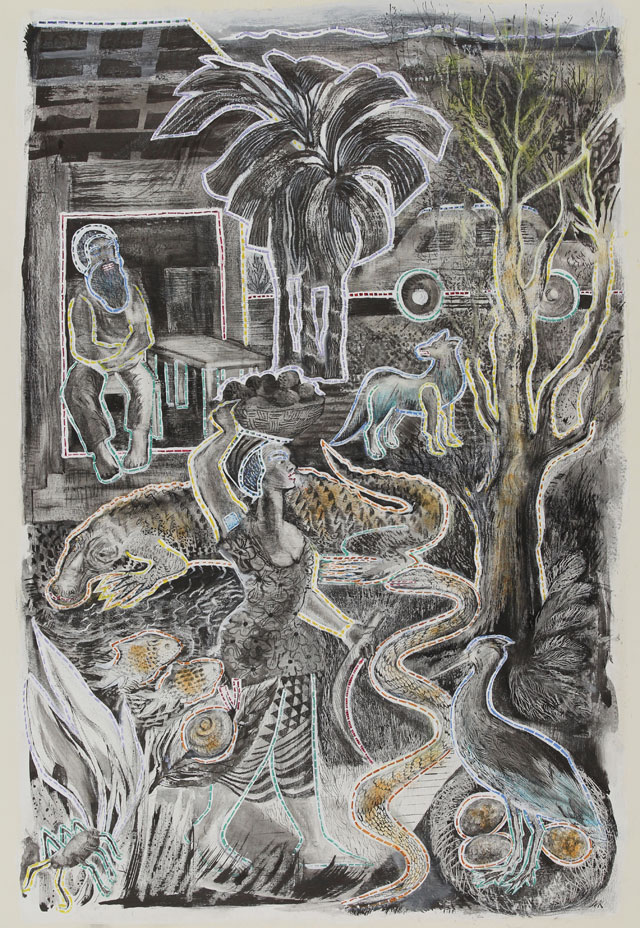
Mary Kuper. The body as metaphor: Dissecting nature, 2017. Ink and watercolour, 56 x76 cm. @ the artist, in collaboration with the Endangered Languages Documentation Project, with support from Arts Council England and University of the Arts CCW Graduate Research Fund.
According to Unesco, which publishes an Atlas of the World’s Languages in Danger, one endangered language on the planet dies every two weeks. The languages included in the works in Language Shift are Breton, Alsatian, Sardinian and Shetlandic. In a short presentation at the opening, Kuper told the audience that making images for these poems was challenging because she needed to consider not only the poetry, “but also the languages and the idea of translation, and the idea of languages in danger. There were many different strands to bring together, and what I really wanted was for the words of those languages to be represented. Because it seemed to me they had to be there.”
But Kuper came up against numerous problems. “I didn’t want to work digitally because it’s so easy to take a body of text that’s there – and funnel it into a different shape … and produce … it on the page without really engaging with it.” She decided to print the poetry using a typewriter. She asked a friend, an expert typist, to undertake the complicated process – counting each letter and each space between words in order to fit the lines of text where Kuper required them to be on the pages.
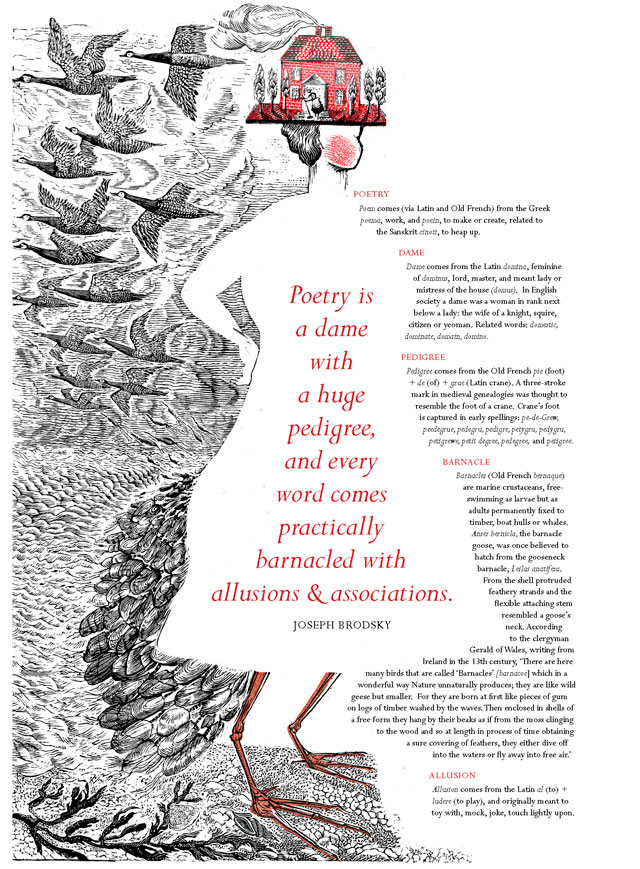
Mary Kuper. Poetry is a Dame, 2012. Letterpress and engraving, 56 x 76 cm. @ the artist, in collaboration with the National Poetry Library, London.
While researching for the work, Kuper realised: “Where you have greater language diversity in the world, you also have greater biodiversity.” The Unesco Atlas of the World’s Languages in Danger also “represents a stripping away of biodiversity”.
Kuper spoke, too, about interesting exchanges she had had with some of the poets. She had “wanted to arrive at where they found difficulty in translating” and, she said: “Some wonderful things came out of that conversation.” She cited a Breton translator and poet “who wrote a poem about the Celts returning to their native land, and used the word ‘glas’ to describe the land they were returning to. ‘Glas’ in the English version was ‘green’, but, in Breton, the colour fields are quite different. ‘Glas’ is blue and green and slate grey, and I thought that [in this case] … where the language was very particularly related to the terrain, it was untranslatable.”
There are all sorts of things, she said, that are really not translatable, and become something else in translation. Another example, she gave was of a Shetlandic poem that used the word “briggistanes”. These, said Kuper, “are stepping stones – huge paving stones – that the Shetlandic fishermen figuratively follow on their way home. We don’t have a word for this in English – [but I noticed] an odd synchronicity – when I was drawing the map of Shetland, I thought the shape of the land was really like stepping stones, so somehow the echoes and resonances [of language reach] across the whole [landscape].”
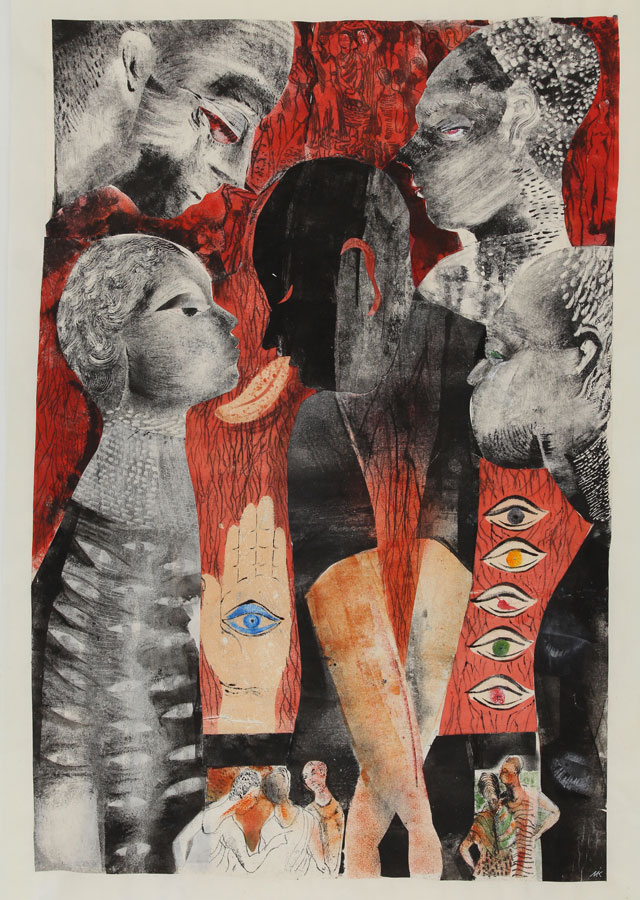
Mary Kuper. The body as metaphor: Envy, 2017. Monoprint, collage, 55 x 77 cm. @ the artist, in collaboration with the Endangered Languages Documentation Project, with support from Arts Council England and University of the Arts CCW Graduate Research Fund.
Kuper has kept sheets of carbon paper that once belonged to her mother, the social anthropologist Hilda Beemer Kuper, who died in 1992. “The idea of using carbon copying, which in the process of copying brings its ‘own character of smudges changes and slips’ seemed to fit with the idea of those changes that occur in translation.” But although Kuper found that applying the carbon was inoperable, she was able to employ the idea of copy and smudge, by allowing each of her images to repeat in a monotype reflection on to the far side of the page. By referencing the imprecise shift from original to copy, Kuper has achieved a beautiful visual echo: there is in the reflected image a subtle essence of the first image, just as occurs in the process of translation. Also referencing the shifting changes of language, Kuper’s works are displayed lifted off their mounts, held in a subtle curve suspended in flight, each one is a page about to turn.
I spoke to Kuper about her passion for etymology, and the works that she has on show at Language Shift, which is at the National Poetry Library at the Southbank Centre in London.
MK Palomar: From an early age, you have been immersed in different languages and cultures. Your mother was from Bulawayo in Matabeleland, Zimbabwe, where they speak Ndebele, and your father was from South Africa, where they speak Afrikaans, and where you spent your early youth. Then your family moved to Los Angeles in California, where language is impacted (perhaps more than anywhere else) by TV and cinema, and the culture is a mixture, primarily, of Spanish and Waspish [White Anglo Saxon Protestant] America. Do you think these different languages and cultures had something to do with your interest in etymology?
Mary Kuper: I’m sure that it’s had an influence on me thinking about cultures as being separate, and language as being representative of different ways of looking at the world. In South Africa, Afrikaans was only one of many languages: we spoke English, but there were many African languages spoken. My mother could speak Swazi, which was very unusual for a white Jewish Zimbabwean, and it’s a language that has a very special flavour – it has click sounds and is very different – so, yes, I’m sure it had an influence. I was also exposed to Hebrew as part of the Jewish liturgy. We weren’t at all religious, but my father had been brought up with that, so that was part of the high holidays, we would be exposed to Hebrew. Then my mother would have Swazi friends with whom she would speak Swazi. My parents also had many friends in the Indian community in Durban, so Hindi would be spoken, and maybe Tamil. I’m not sure how many languages, but it was just everywhere, and different sorts of people were everywhere. A language and a people and a way of living were all part of the same thing.
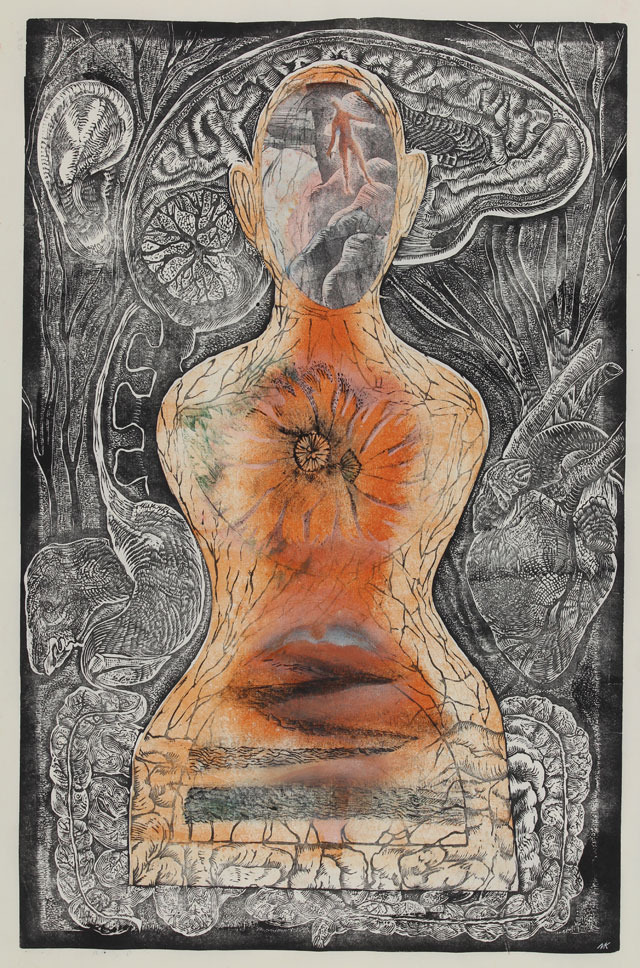
Mary Kuper. The body as metaphor: Happiness, 2017. Engraving, monoprint, collage, 52 x 80 cm. @ the artist, in collaboration with the Endangered Languages Documentation Project, with support from Arts Council England and University of the Arts CCW Graduate Research Fund.
MKP: Do you think that was particular to your family because they were social anthropologists?
MK: My mother was a social anthropologist and my father was a sociologist, but I think it would be hard to live in a politically aware family in South Africa and not be aware of the tribal and racial divisions and separate cultures. It was a very multicultural place, but the cultures were separate.
MKP: Other people may have grown up politically aware, but not had any interaction with people from other cultures. Was it your parents’ political and social awareness that meant you were immersed within many cultures as a child?
MK: I think South Africa is intensely tribal – I mean, you were Afrikaner or Portuguese or Indian or Zulu, and those groups didn’t mix socially very much, but my mother didn’t observe those boundaries between people; my father neither, although more from an ideological basis. Of course, as white South Africans, they had some freedom of choice in these matters that were not available to most South Africans, but these choices, too, became eroded as apartheid became more and more entrenched, and most white people chose to remain within the safety of their familiar culture.
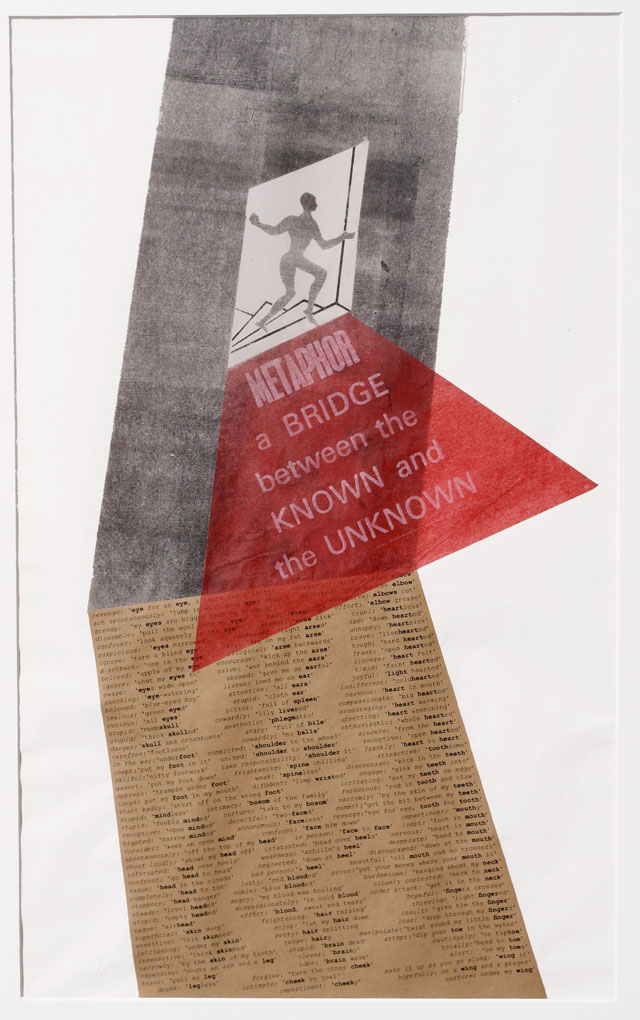
Mary Kuper. A metaphor is a bridge, 2017. Monoprint, digital type, collage, 56 x 90 cm. @ the artist, in collaboration with the Endangered Languages Documentation Project, with support from Arts Council England and University of the Arts CCW Graduate Research Fund.
My mother was very different from the others in her family: she went to university in South Africa and to the London School of Economics in England. In the 1930s, she was training to be a social anthropologist: her fieldwork was in Swaziland and she lived there, in the royal compound. Perhaps she was lucky: as the youngest in her immigrant family, she got away with it. Her elder sisters had married a doctor, a lawyer and a dentist respectively, and her brother became a doctor. She managed to escape expectations, perhaps.
MKP: What an unusual woman for her generation, and also an unusual woman to have as a mother.
MK: She said my father was an unusual man in that he tolerated her unusualness – in that era, that would have been quite unusual. But I was certainly exposed to lots of different currents. Even going to Los Angeles – where, theoretically, it was the same language – it was a very different language, and particularly for my parents who were in their 50s and not that flexible, and they made mistakes with language. I was very aware of the nuances and how different words meant different things in different places, even if it was the same language. So language is always problematic and present, and I was really interested in it. I was aware that it was different and weighty.
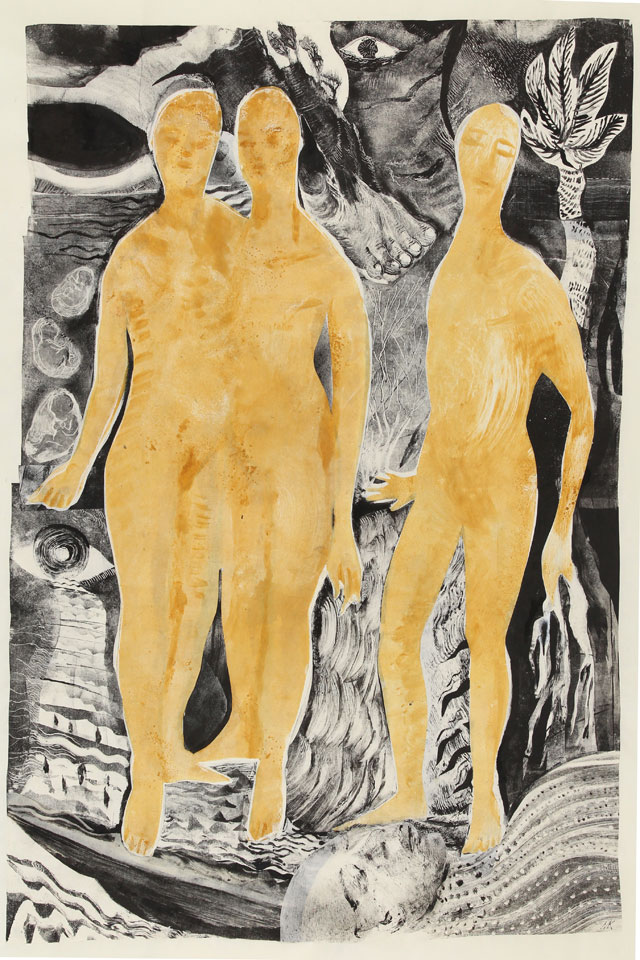
Mary Kuper. The body as landscape, 2017. Monoprint, collage, 52 x 77 cm. @ the artist, in collaboration with the Endangered Languages Documentation Project, with support from Arts Council England and University of the Arts CCW Graduate Research Fund.
MKP: Different from culture?
MK: Language wasn’t a universal currency – nothing meant the same, everything was slightly different. You sort of had to watch it. I think that made me want to know more about it.
MKP: When did you start working with language?
MK: I studied linguistics for a while, but it was a very old-fashioned kind of philology – it was before [the US linguist and philosopher Noam] Chomsky.1 You’d look at a word in Sanskrit or in High Church Slavonic, in many different Indo-European languages, and look at the connections between them, but not so much in meaning as in the way sounds had shifted. It was very boring, and I was irritated by how pedantic it was. People devoted their lives to looking at why a word that had a ‘ch’ sound in one language had a ‘k’ sound in another, and I couldn’t see myself spending my life that way. I was ambivalent about academia and felt that all the interest was being stripped out of the subject by this approach (which I acknowledge now, you have to have that level of pedantry to get underneath the skin of something). I was much more interested in meaning and the kind of poetry of it. So, I never pursued linguistics and then I started working as an illustrator.
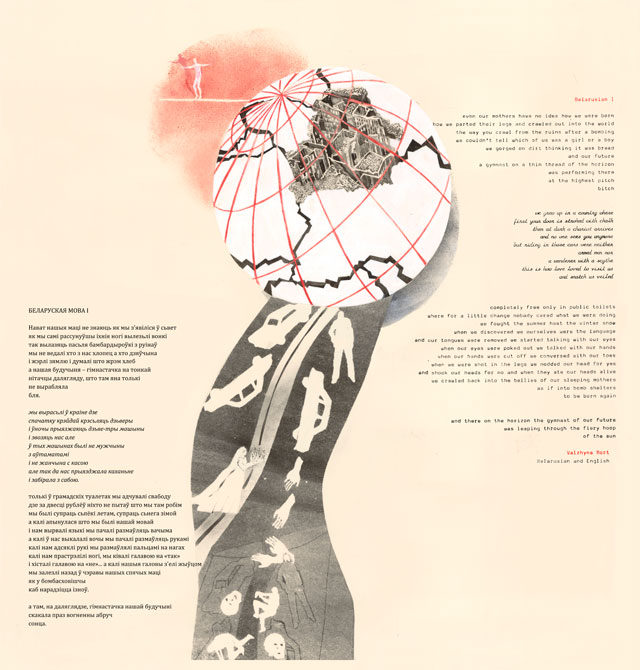
Mary Kuper. Endangered Poetry: Belarusian, 2018. Monoprint, gouache, digital type and typewriters, 50 x 52 cm. @ the artist, in collaboration with The National Poetry Library, London.
MKP: How did that happen?
MK: That was purely by chance. I was very lucky, I had a friend in Los Angeles, Scott Freutel, who liked typography. I didn’t know anything about typography or much about the visual arts.
MKP: So, back to words?
MK: Yes, he liked typography and he liked dictionaries. He was working in publishing, sort of, and was allowed to have a little imprint of his own. He chose to reprint some dictionaries, with new title pages that were set by a very fine typographer and printer in Los Angeles. This was Saul Marks at the Plantin Press, and Scott introduced us. I had no idea what I wanted, where I was coming from or who I was, but Saul and I took to one another and, in him, I found a mentor, and he took me on to work for him. The wood engraver he worked with had just died, and Saul had a set of wood-engraving tools. He gave them to me and said: “Let’s see how this goes.” I was 21 – it was really, really lucky. Saul was a wonderful man, the sort of person who made you want to do your best, a perfectionist with a sense of humour. The Plantin Press was named for Christophe Plantin, a printer and humanist from the Renaissance. So, through Saul, I started typesetting and printing, as well as illustrating. It was an amazing break because, although I’d always liked drawing, I’d really hated school from the time when we went to America.
MKP: Why did you hate school?
MK: I was lost, I felt strange, I didn’t belong in that culture. I didn’t know who I was and I stood out, I spoke differently. In those days [the 1960s], LA was very static. In our school, as I remember it, there were kids of Japanese origin, there were Hispanic kids, there were Wasp kids and there were Jewish kids, and, somehow, I didn’t feel any of those things. I felt every time I opened my mouth, people looked at me and I became shyer and shyer. So, I hated school. There were art classes, but I never took part, although I used to make things a lot at home. I kept it apart from school.
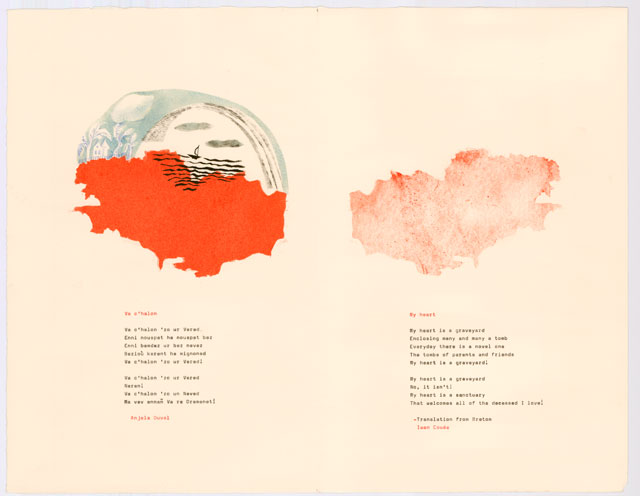
Mary Kuper. Endangered Poetry: Breton, 2018. Monoprint, watercolour, typewriters, 50 x 35 cm. @ the artist, in collaboration with The National Poetry Library, London.
MKP: What kind of things did you make?
MK: Intricate things – I’d cut up bits of paper and make hanging things – and pictures with words. I was often making things.
MKP: How long did you work for Plantin Press ?
MK: For two or three years. Saul Marks died, which was very sad, and I stayed and worked for his widow and helped her to finish up some projects. I had this portfolio of wood engravings that were completely self-taught and very delicate – not strong enough, thinking about it now – but they were interesting in their own way. I must have been really short sighted to be able to do it – wood engraving is really tiny work, it’s just lucky that I had that kind of eyesight (laughs) that fitted that kind of tool and I loved it and I still love it. I love the intricacy of it, and I like working white out of black – I still use the tools Saul gave me.
MKP: And the intimacy of it – the mantling of it?
MK: Yes, and the way you can go into it and it takes days – you’re inside that zone. Tools will make different marks, which are not alterable; you can’t smudge them or move them about, so it’s very fixed, which makes you quite decisive.
MKP: Moving forward a little, how did you end up coming to England?
MK: My partner at the time was from the east coast and part Argentinian, so not entirely American. We didn’t like LA and he had connections in England and so did I. My parents had always said that they would go back to England when they’d finished working. They’d had to leave South Africa because they were active opponents of the government, and had gone to work at the University of California Los Angeles. My mother had not wanted to go to LA and the idea was that they were on their way to England, that never happened, although my sister and I both ended up in London.
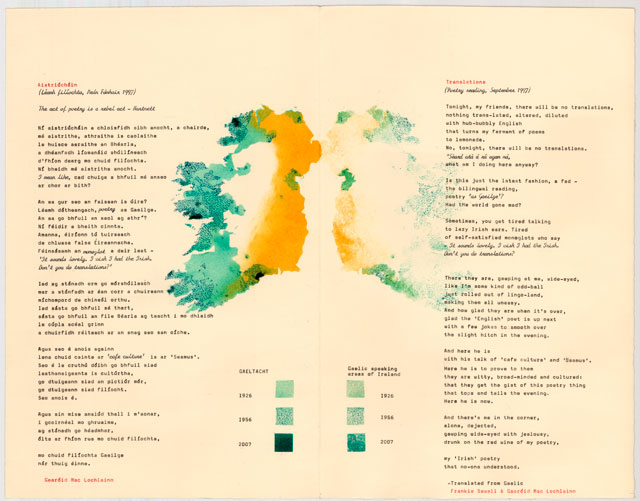
Mary Kuper. Endangered Poetry: Irish Gaelic, 2018. Monoprint, acrylic ink, typewriters, 50 x 35 cm. @ the artist, in collaboration with The National Poetry Library, London.
Anyway, myself and my partner went to London and I went around a little bit with my portfolio of work from Plantin Press. People looked at me like I was a ghost of Christmas past (laughs), it was so anachronistic, it was of a different time somehow – this wood engraving, although there always has been wood engraving in England, it never went away. But I didn’t understand the world enough, and I was daunted by the process. I was also conflicted politically because in this fine-press world – the world these wood engravings belonged to – people bought these very finely crafted books, the sort of thing Plantin Press did, for the quality of the paper and the quality of the craftsmanship and the rarity of them. It was exactly that aspect of the art world that is almost like banking, not for the people producing it, but for the people acquiring it and storing it, which I was uncomfortable with.
The more political I became – and I was pretty political – the more uncomfortable I was with that world. Because I had learned how to run printing presses at Plantin Press, I ended up working for a printer, in a shed in Willesden, in London, where they had a Heidelberg Windmill letterpress, which I knew how to operate. At that time, outside the fine-press world, letterpress was almost at an end in Britain. But here, they used it to print invoices. They had these numbering machines: you fed in the paper, a pink sheet, a yellow one, a blue one and a white one, all needing to be printed with the same number, and these things would jam often – it was a complete nightmare – and the numbering machine went so fast that it wouldn’t be until about 300 sheets later that you would realise everything was out of sync. It was a horrible job – but after that I found the world of the co-operative press world and the alternative press and that was really sympathetic and congenial.
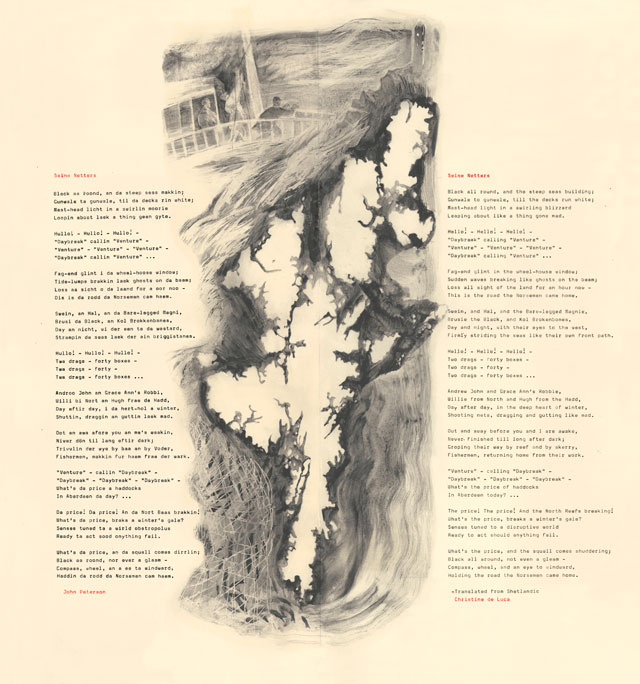
Mary Kuper. Endangered Poetry: Shetlandic, 2018. Graphite, typewriters, 50 x 52 cm. @ the artist, in collaboration with The National Poetry Library, London.
MKP: Where was that?
MK: I worked for Expression printers running quite a big press: they printed things like [the photographic journal] Camera Work and a lot of local history in Hackney. Then I worked at Black Rose, an anarchist press in Clerkenwell, central London, and then at Calverts, a cooperative printing press, which was in Mount Pleasant, off Grays Inn Road, but is now in Hackney. When I worked there, it was political in the way it was organised, with equal pay for everyone, and it was political in much of the content we printed. At Calverts, I was working as an art worker, doing layout, sticking things together using Cow gum, before computers.
I had a son by then and was making toys for him. I really got into wanting to make things again and at that point [1983], I went to Chelsea College of Art and Design to do a BA in illustration. The head of the department was Susan Einzig, who became a really good friend: it was another stroke of amazing luck meeting her. She taught me a huge amount and introduced me to many things that formed me, in art, literature, philosophy and life in general.
MKP: From there, you became a practising illustrator?
MK: Yes, I freelanced and also always taught, usually two days a week, at different colleges. The first teaching job I had was at Anglia Ruskin University in Cambridge, I think, but I taught at many colleges and am still happily teaching at Camberwell College of Arts [University of the Arts London].
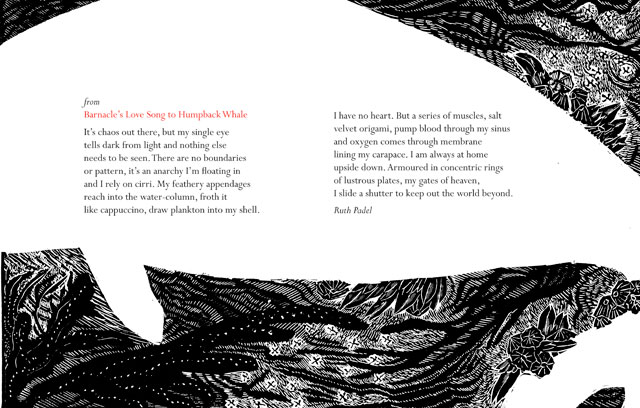
Mary Kuper. Barnacle’s Love song to Humpbacked Whale, Ruth Padel, 2012. Engraving and digital, 44 x 29 cm. @ the artist, in collaboration with The National Poetry Library, London.
MKP: Can we jump forward now to the work you have done with words and images.
MK: Yes, we jump forward really a long time. It was about 2002 when I realised I could bring together my interest in language, which hadn’t gone away really, and my interest in image-making.
MKP: And 2002 was the year you won the Clarion/FPBA award for your book An Alphabet of Word Origins. Can you tell us how you came to do this work?
MK: The idea of doing an etymological alphabet seemed to me to be a good possibility, and what I explored was that in a single word there is a whole story. As an illustrator – the sort of illustrator I am – if you’re really interested in story-telling, there’s always an issue about finding a story where what you do with images doesn’t repeat what’s being done with words. If you take a single word and look through its history, it’s all hidden – all those narratives, all those stories are hidden in that one word and you can unearth them, so the images are telling something that hasn’t been put out there.
For example, “clue”. A clue, sometimes spelled clew, is a ball of wool; it has to do with the string that you would follow in a labyrinth, it’s the way in which you would unravel a piece of string in order to find your way, the thread that Ariadne gives Theseus to help him find his way out of the Minotaur’s labyrinth.2
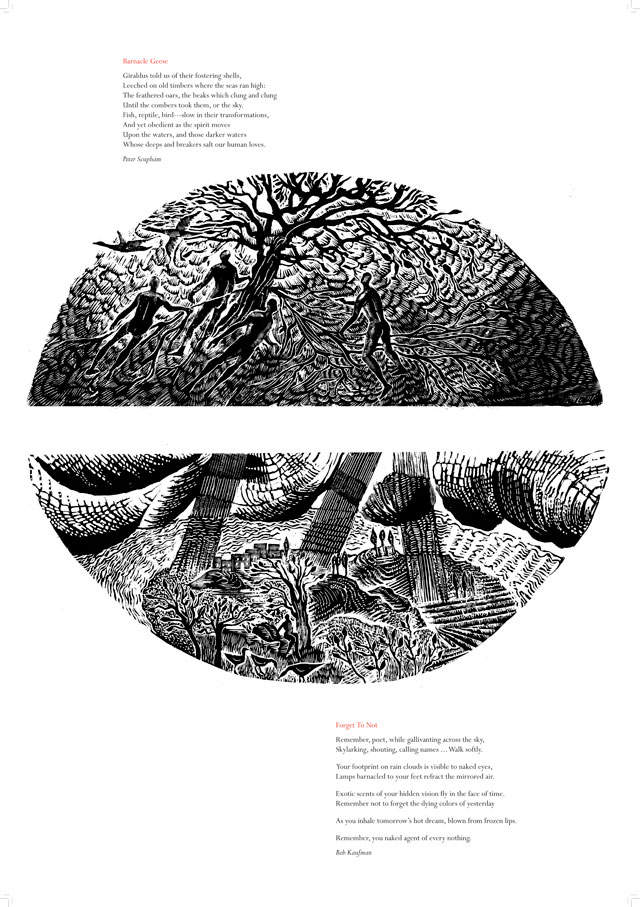
Mary Kuper. Poetry is a Dame: barnacle, 2012. Engraving and digital, 56 x 78 cm. @ the artist, in collaboration with The National Poetry Library, London.
MKP: It’s a clue to get somewhere?
MK: Yes, and – another example – the word “vogue”3 comes from a German rowing term, with the implication of drifting along smoothly in the waves. So, you could illustrate vogue with waves and people being swept along with the waves and it would be adding sometime to the understanding of what the word was that wasn’t obvious. I found that really interesting, that you could tell the story in different layers in the imagery. I also like playing with the alphabet itself, with the physical forms of the letter. I realise that I like having something I can anchor an image to, so the physical form of the letter made a shape that the illustration could take place around. Like illuminated letters, there’s a big tradition of that, and I love that stuff.
MKP: You received a Leverhulme grant in 2009 undertaking a Leverhulme arts residency working with the University of Winchester’s English Project. Can you tell us about that project?
MK: Having done the etymological dictionary, I had continued looking at the stories in words and I have notebooks full of these amazing things that related to every single aspect of life, like “pavlova”, for example, the meringue with cream and fruit named after the ballerina Anna Pavlova, all light and fluffy like a ballerina in a tutu. Or “desultory”, which comes from a Latin word for a circus performer who leaps from one horse to another. There were food words, there were political words, there were gender words, there were plant words, every different area of human activity had words that, in their origin, told stories very different from the current meaning. They evolved from one to the other, but the story was hidden, and I really wanted to do more with it.

Mary Kuper. An Etymological Alphabet : V, 2002. Acrylic ink and digital, 14.8 x 21.0 cm. @ the artist, Clarion Press and Fine Book Association Award.
I had all this research, which I was just accumulating. And I read about the project at the University of Winchester and they agreed to collaborate on this and I had a year to work on a series of illustrated etymologies of English words. It became several exhibitions and a book about the origins of some plant and animals words as well, so the book had words in it, such as “panic”. The word panic comes from the god Pan, that when he’s present among flocks of animals, there’s a sort of frisson of alarm (laughs). So, panic is a plant and animal word, although it’s also an emotional word – I wanted to play with that ambiguity of categories. My plan was to make a series of 10 books each with 20 words. But there were other projects I was working on, so I haven’t returned to this yet, although I hope to go back to it. I did post a definition of “Tory” on Instagram, at the time of the last election; it comes from the Middle Irish word “tóraidhe”, which in the 10th-12th century meant an outlaw, a plunderer. But then I became increasingly interested in issues around languages other than English.
MKP: You have worked for some time with the endangered languages projects at Soas University of London [formerly the School of Oriental and African Studies]. Can you tell us more about that, and is it connected to the National Poetry Library’s Endangered Poetry Project?4
MK: Yes, it’s definitely connected, I read about the Endangered Languages Documentation Programme at SOAS, and it was the first time I wished I had remained a linguist. I wished I could go out somewhere and document one of these languages; it’s the only time I ever regretted leaving that route. Then I thought perhaps I could do something with them and I got in touch with Dr Mandana Seyfeddinipur, who is the director of the programme, and a very knowledgeable, very charismatic woman. The programme has archives of recordings and transcriptions of about 300 languages. They train researchers, who are often people from the region (of the endangered language), in how to collect the language, and then all the information is deposited in the programme’s database.
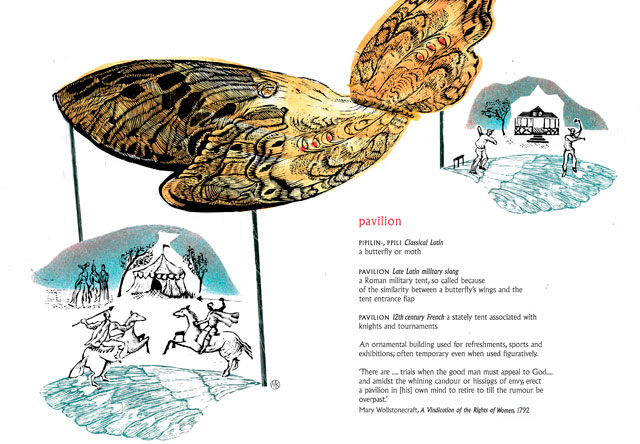
Mary Kuper. Word Origins: pavilion, 2011. Engraving, monoprint and digital, 29.6 x 42 cm. @ the artist, with support from the Leverhulme Trust and the English Project at the University of Winchester.
The problem with the database is that it’s very hard for a lay person to access – not everything is translated and searching the archive requires a depth of knowledge. Translation in itself is a problem. One of the things we wanted to do in our collaboration was to make access to their really rich collection of endangered languages more possible. The money for the programme is ring fenced for collecting the languages. And the urgency in collection is huge because the languages are disappearing so fast, so the imperative thing is to get it, record it and keep it and then, hopefully, at some point get funding to make it more accessible.
I thought of a project that seemed possible, but was, in fact, more difficult than I thought. The starting point was to take something universal, shared by all people, then look at how this universal is expressed in several different languages – so, how a universal is not universal in the way it’s conceptualized and the filter it’s going through is language. I took the body and emotions: I thought, those are two givens, every human being has got a body with a similar structure, and we experience emotions and the body is used as a metaphor in expressing emotions. It’s a big topic in psycholinguistics and I thought I could start with the generalities of this, that there would be something unifying, but there would also be something very particular in each culture, and there is, of course. In English, green-eyed means jealous, but in Ewe, for example, an African language, red-eyed means jealous. It’s a very obvious example, and everywhere you look there were examples of how in English, for example, we conceptualise love as being in the heart – you know, “your heart is broken’, whereas, in other places, the liver is the locus of feeling, so your liver is broken or compromised in some way. There are also examples to do with how the body is categorised. Unlike in English, in the South Mande languages spoken in west Africa, humans and animals (including birds, reptiles, insects, molluscs and so on) are considered to have the same body parts. So the word gbɛ̄ means “hand+arm of a person”, “foreleg or forepaw of an animal”, “branch of a tree”, “side of an object (eg of a house)”, “manner, way”.5 Everywhere reality is differently expressed – there is a quote from the linguist Benjamin Whorf: “We dissect nature along lines laid down by our native language.”6
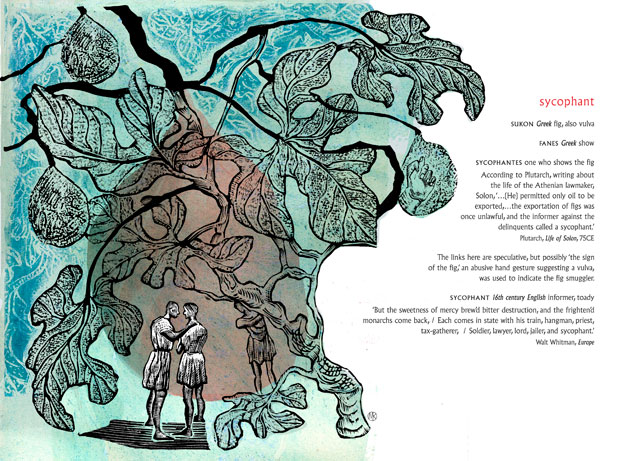
Mary Kuper. Word Origins: sycophant, 2011. Engraving, monoprint and digital, 29.6 x 42 cm. @ the artist, with support from the Leverhulme Trust and the English Project at the University of Winchester.
I was really fascinated by that, so I made work about how emotions are expressed in different languages. I looked at happiness, at mindfulness or thought and at anger and jealousy. And I looked at the naming of body parts as well, and the way in which the body is used as metaphor in language, in English. For instance, I looked at “his heart was in his mouth”, “his heart sank” – there are hundreds of these body metaphors. In a one-hour bus journey, I filled five pages with body metaphors from English. They appear perfectly obvious to an English speaker, but they are neither obvious nor directly translatable. We use our body as a reference, but we all use it differently; different languages use it differently. I wanted to express these things without words, I wanted to use images to express it, and I could up to a point, but I found I needed explanatory sheets as well. I could express the feeling of it, but it is in the particular that it was so interesting. I found that outcome really challenging because I didn’t want to rely on an English translation. In itself, that leads to the assumption that everyone conceptualises reality as English speakers do. I sort of did it without words, but what was interesting about it; it needed to be expanded on, using words (laughs). I found that really frustrating with the endangered languages and body as metaphor work, I wanted to do it without words, but I couldn’t.
MKP: How did that work that you were doing at SOAS move over to the National Poetry Library?
MK: I’d done a project at the poetry library in 2012 for the celebration of the 100th anniversary of the beginning of its collection. I made work and put together an exhibition based on a quote I found by Joseph Brodsky: “Poetry is a dame with a huge pedigree and every word comes practically barnacled with allusions and associations.” It was exactly what I was interested in, the way in which if you unpack a word you find stories, and I found poems in the collection that contained the words in that quote and made an exhibition with that. So, I’d worked here before, and I was talking to Chris McCabe, the poet and National Poetry Library librarian, and he had been thinking about expanding the library’s collection to include a greater focus on the endangered languages of the British Isles, and was thinking about endangered languages in general and he linked up with SOAS. He put out a call (on National Poetry Day last year) asking for poems in endangered languages and got between 30 and 40 poems, and he asked me if I would put together an exhibition about that.
MKP: And that’s how this exhibition, Language Shift, came about?
MK: Yes, Chris also commissioned some poems. He commissioned a poet from Uganda, a Muskogee-speaking poet from the US and an Irish Gaelic poet. Most of the submitted poems came from Europe, and it was a bit unrepresentative globally, so it was easier to put something together that had some substance that was Europe-focused – although I’m sure, in the future, the contributions will be more diverse. This is the first round, but Chris is asking for new submissions now.
It’s weird how it works. I was at a wedding, sitting next to a young woman, and I told her about the Endangered Poetry Project. It turned out that she’s a Macedonian, from the former Yugoslav Republic of Macedonia, and speaks an endangered language, Aromanian. She was telling me how important that is to her identity and how difficult it is to be an Aromanian, and suddenly the value of it become really apparent. People say things to her that are familiar to us from other aspects of European history, and not just European history. They say things like: “You don’t look like an Aromanian.” To her, this means she is not that ugly – it’s a kind of backhanded compliment – but her identity, her language, everything is compromised by the disregard for what is unique about her. So, when I was doing this work I was intensely aware that it’s important, that these languages represent something. It’s a conflicted thing because, of course, it can fragment into nationalism in a way that is regressive – you don’t want the world to fragment into groups of people who hate one another because they speak different languages. But, in another way, it is hugely valuable to respect what’s unique in a specific cultural identity. On the map [Kuper has drawn a world map marking the locations of endangered languages, according to the Unesco Atlas of the World’s Languages in Danger], you can see that Europe is linguistically not diverse, and that’s reflected in the biodiversity. There’s a wonderful book by Nicholas Evans, Dying Words,7 in which he talks about the highly descriptive name for “April” in Seri (which has around 500 speakers in Baja, California): “April= … ‘moon of the eelgrass harvest’ and the onset of harvest time is signalled when the black brant bird … ‘the foreteller of eelgrass seed’ dives into the sea to feed on the grass.” The eelgrass itself is the only known example of a grain being harvested from the sea, with potential as a new food source for humankind. And nobody would know it was there or how to find it if you didn’t know this route through language of the name of the month and the name of the bird and the name of the grass. So, learning a lesson from the body as metaphor project, I wanted the words to be there in the original and in English translation and I wanted to reflect the fact that they’re not in any way the same, that the original and the translation have their own identities. With poetry, perhaps this is more crucial, more obvious, because it is understood that the words convey more than the literal meaning. I wanted somehow to make the location of the language central to the images, because geography tempers a language and makes a particular vocabulary essential. I wanted to bring geography into it and so I thought I’d use the map, those shapes (in the map) as a way of starting the image.
The starting point wasn’t illustrating scenes, if you like, from the poems, it was using the map as a device that both tied them all together and gave them a particular shape. It was really helpful because drawing those shapes, for instance Shetland is ridiculously complicated, it is serrated almost, it’s completely fragmented, and then you look at Belarus and it’s landlocked, and it’s pressed in from all sides, and the fact that Brittany looks quite a lot like a heart. There are odd little bits of meaning that, without intending to, you find by looking at the shape of the country, and those shapes of those countries fed into the imagery, it all seemed to come together once I’d thought of using the map. I had a long struggle before I got to the map, I didn’t want only to explore the imagery of the poems, I wanted to illustrate the languages giving a form to the poems, and geography giving a form to the languages.
References
1. Al Page speaks with linguist Noam Chomsky about how languages are systems of communication rooted in human nature. youtu.be/hdUbIlwHRkY
2. An Alphabet of Word Origins: from Alcohol to Zen by Mary Kuper, published by Clarion Publishing, 2003.
3. Ibid.
4. The Endangered Poetry Project: southbankcentre.co.uk/blog/endangered-poetry-project
5. Body parts and their metaphoric meanings in Mwan and other South Mande languages by Elena Perekhvalskaya. In: Mande Languages and Linguistics: 2nd International Conference, edited by Valentin Vydrine, published by Meabooks, 2015, page 121.
6. Language, Thought, and Reality: Selected Writings of Benjamin Lee Whorf, edited John B Carroll, Stephen C Levinson and Penny Lee, published jointly by MIT and John Wiley, 1956, page 213.
7. Dying Words: Endangered Languages and What They Have To Tell Us by Nicholas Evans, published bythe Language Library, New Jersey, 2009.
• Language Shift, an exhibition of work by Mary Kuper that responds to the National Poetry Library’s collection of poems in European languages, is at the Southbank Centre, London, until 23 September 2018.